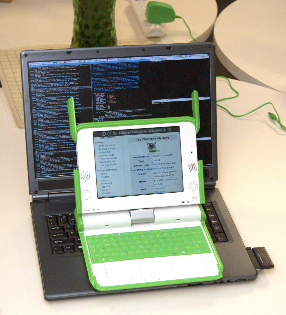Emulating the XO: Difference between revisions
(make link bold) |
(clarify file names. link latest devel img.) |
||
| Line 59: | Line 59: | ||
|- |
|- |
||
| development-ext3.img |
| ...development-ext3.img |
||
| ~monthly || yes/B || no || yes || yes |
| ~monthly || yes/B || no || yes || yes |
||
| yes || no || after config |
| yes || no || after config |
||
| Line 65: | Line 65: | ||
|- |
|- |
||
| development-devel_ext3.img |
| ...development-devel_ext3.img |
||
| ~monthly || yes/B || no || no || yes |
| ~monthly || yes/B || no || no || yes |
||
| yes || a little || after config |
| yes || a little || after config |
||
| Line 73: | Line 73: | ||
|- |
|- |
||
| development-ext3.img |
| ...development-ext3.img |
||
| ~daily || yes/B || no || yes || yes |
| ~daily || yes/B || no || yes || yes |
||
| yes || no || after config |
| yes || no || after config |
||
|- |
|- |
||
| [http://olpc.download.redhat.com/olpc/streams/development/LATEST/devel_ext3/olpc-redhat-stream-development-devel_ext3.img.bz2 ...development-devel_ext3.img] |
|||
| development-devel_ext3.img |
|||
| ~daily || yes/B || no || no || yes |
| ~daily || yes/B || no || no || yes |
||
| yes || a little || after config |
| yes || a little || after config |
||
Revision as of 23:33, 9 June 2007
Quick Start - LiveCD
For many, the LiveCD is the easiest way to try Sugar. It's easy to do, but your work is lost when you reboot.
Quick Start - Emulation
Emulation is the other way to try Sugar. It can be harder to set up,, but work is preserved.
- Sound in TamTam may not be working at the moment. MitchellNCharity 13:16, 5 June 2007 (EDT)
Overview
One way to run oplc software is using an emulator on your pc. See Getting started programming for other options.
Note Category:Emulation and Help and tips.
For play, you can use LiveCd or Quick Start.
For development, you can use LiveCd, or qemu (as in quick start, but with a different image), or perhaps one of the Developer Images other than the LiveCd. An alternate approach is to attempt installing sugar. See Getting started programming for a comparison.
A common development approach is to use QEMU with kqemu acceleration. See Quick Start for the basics. Though for development, we will use a different .img, one with a few extra utility programs. See OS images, including latest stable build.
Instead of qemu, you can run VMware, and there are additional options on a Mac.
Please report your experiences in User Feedback on Images. There is a Virtualization Common Room.
There are limitations with XO disk images.
Developing software
Developing on emulation is one alternative for developing software.
After looking at /Quick Start, see /Help_and_tips#Development for how-to's. It should be straightforward on linux.
Comparison of alternatives
An OLPC laptop is custom hardware, running a stripped-down Red Hat linux, running Sugar. But what if you don't have a real olpc laptop? There are a several options.
| option | updated | sound? | camera? | library? | etoys? | R/W? | development software? | net? | comments |
|---|---|---|---|---|---|---|---|---|---|
| LiveCd | April | yes(boot) yes?(qemu) | yes?(boot) no(qemu) | no | yes | no | toolchain, Gnome | yes? | Alternative Quick Start. Good for new developers. Can both be booted from, and used in qemu. Problems: A. |
| XO disk images: | |||||||||
| LATEST-STABLE-BUILD http://olpc.download.redhat.com/olpc/streams/development/LATEST-STABLE-BUILD/ | |||||||||
| ...development-ext3.img | ~monthly | yes/B | no | yes | yes | yes | no | after config | Quick Start for getting a look at Sugar. |
| ...development-devel_ext3.img | ~monthly | yes/B | no | no | yes | yes | a little | after config | |
| LATEST http://olpc.download.redhat.com/olpc/streams/development/LATEST/ | |||||||||
| ...development-ext3.img | ~daily | yes/B | no | yes | yes | yes | no | after config | |
| ...development-devel_ext3.img | ~daily | yes/B | no | no | yes | yes | a little | after config | Good for new developers (requires some command-line comfort). |
| OTHER | |||||||||
| FC6+Sugar | April | yes? | ? | ? | no | yes | Full Fedora Softare Dev. | yes | 6GB (April version: no etoys) |
| Installing Sugar | continuous | yes | yes? | yes? | yes | yes | your own | yes | Quite hard to do. |
Key:
- library: A library of sample content is included (english version). Ie, pretty text to web browse without having to get network.
- R/W (writable): With an .img, you can save things between sessions. With a .iso, your environment is the same each time you start.
- development software: are development tools included?
- Net (network): does the network "just work" or "manual" steps are required?
Problems:
- A: LiveCd (April) on fc6 x86_64, kernel panics under kqemu. A squashfs problem.
- B: Tam Tam is silent (though EToys makes noise). Cause unknown.
Notes:
- re "does sugar-jhbuild support camera/mic?": "yes, if the camera uses v4l2 and 640x480, I'd suspect so." Can someone confirm this? (#olpc, now) MitchellNCharity 00:16, 2 June 2007 (EDT)
Doables:
- Remove LiveCd's "?" above.
- Find out what's going on with Tam Tam sound. It would be nice for the xo disk images to all be sound-yes.
- Add a microphone column? Reconsolidate sound/camera/mic into a H/W column?
